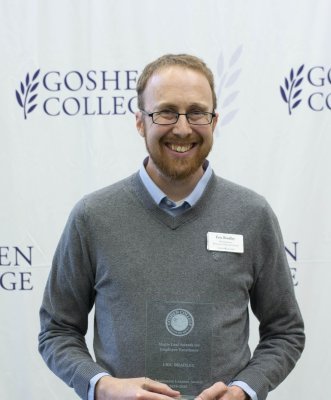Make a donation for Giving Tuesday and have your gift doubled! Give now

Mennonite Historical Library
One of the world’s most comprehensive collections related to Anabaptist and Mennonite history
Founded in 1906, the Mennonite Historical Library (MHL) at Goshen College maintains one of the most comprehensive collections in the world related to the Radical Reformation, Anabaptists, Hutterites, Mennonites, Amish, and other Plain groups. These qualities have made the MHL an indispensable resource for a wide range of local, domestic, and international scholars. As part of the Institute for the Study of Global Anabaptism (ISGA), the MHL serves to connect individuals and communities in pursuit of equitable and accessible source preservation, research, and publication that engages global Anabaptism.

Regular hours:
Monday-Friday: 8 a.m.-5 p.m.
Access to the library may change during holidays, semester mid-term and final breaks. The Library Gallery is open whenever the main college library building is open. See here for library building hours.
We encourage off-campus researchers to contact us in advance of visits. Additional hours may be available for researchers. Additional information on special hours, facilities, fee structures, and access policies is posted here.
Location
We are located on the 3rd floor of the Good Library on the campus of Goshen College (Goshen, Indiana).
Contact us
Phone: (574) 535-7418
Fax: (574) 535-7438
Email: mhl@goshen.edu
See the Institute for the Study of Global Anabaptism to read about our current program initiatives.
Texts and Bibliographies
- Harold S. Bender, The Anabaptist Vision (1943): In December 1943, Mennonite historian and theologian Harold S. Bender delivered a presidential address to the American Society of Church History entitled “The Anabaptist Vision.” This address is a classic statement of key Anabaptist-Mennonite convictions.
- John D. Roth, ed. Refocusing a Vision: Shaping Anabaptist Character in the 21st Century (Mennonite Historical Society, 1995): In the fifty years since Harold Bender delivered his presidential address to the American Society of Church History, The Anabaptist Vision has become a focal point for renewal and identity within the Mennonite church. In this collection of essays, six young Mennonite leaders offer their insights on the continued relevance of The Anabaptist Vision for the church in the 21st century.
- Mennonite Confessions of Faith
- Mennonite Life Bibliography (an annual listing of recent publications on Anabaptist, Mennonite, Amish and Hutterite topics from the collections of several North American Mennonite historical libraries)
- Anabaptist Primary Sources Available in Translation (1990, English and Spanish)
- Mennonite and Amish Folklore Folk Art (Bibliography by Ervin Beck)
- Mennonite/s Writing Bibliographies (comprehensive list of literary writing done by Mennonite writers in North America in English)
- Conscientious Objectors & the Draft: A Small Bibliography of Materials Available in the Mennonite Historical Library
Frequently Asked Questions
What is my old book worth?
The Mennonite Historical Library frequently gets questions regarding old books and especially old Bibles. These questions fall into several categories:
- Is anyone interested in this book?
- How much is this book worth?
- How can I best preserve this book?
The answers to these questions can be simple or very complex depending on the items in hand. Many factors go into determining the value of old books, including condition and rarity. Old books can remain in extremely good condition if they have been stored carefully. If a book has spent several generations in hot attics or damp basements it may be in poor condition. The value of old Mennonite books more often tends to be historical or sentimental rather than monetary.
The MHL can offer an assessment of the condition and significance of books as they relate to Anabaptist-Mennonite groups. Accurate assessments require on-site examination of the items. (Check with us in advance to make sure the proper staff members will be available. We cannot provide formal monetary appraisals. Although we are not professional conservators, we can provide some basic information on what steps may be beneficial or detrimental in preserving historical items.
The MHL continues to add both new and old items to our collection. Sometimes the tattered little booklet you have is one we need. We are happy to look at twenty books we do not need in order to find one which may be important to us. We are also glad to suggest other collections which may be able to use the items we already have represented in ours. A helpful web site answering many common questions is Your Old Books, prepared by The Rare Books and Manuscripts Section of the Association of College and Research Libraries. The late Peter VanWingen (a Mennonite) authored an earlier version of the text.
Another helpful article, What Is That Old Bible Worth?, appeared in The Bible Collector, the journal of the International Society of Bible Collectors, No. 54, April-June 1978. Written by the late Arnold Ehlert, we originally posted it on our website with the permission of the Society’s president at the time, Mennonite pastor Gerald C. Studer.
Who are the Amish?
Who are the Hutterites?
Who are the Mennonites?